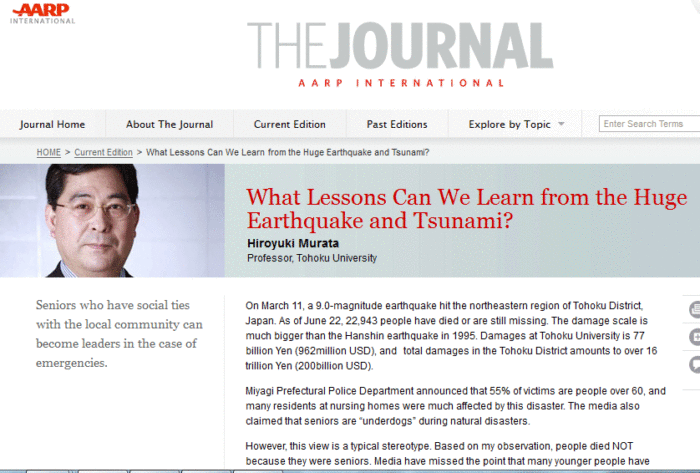2011年7月4日 AARP The Journal
全米最大の高齢者NPO・AARP(エイ・エイ・アール・ピー)が発行するThe Journalに「What Lessons Can We Learn from the Huge Earthquake and Tsunami?」と題した寄稿記事が掲載されました。
超高齢社会・日本において東日本大震災とその後の津波が高齢者にどのような影響を及ぼしたのかは、AARPの大きな関心事の一つです。
未曽有の震災から学ぶべきことは山ほどあり、震災後4カ月が経過した今でも総括できているわけではありません。しかし、25,000人を超える尊い犠牲を決して無駄にしてはならず、私たちは少しでも多くのことを学ばなければなりません。
AARP The Journalに掲載の寄稿記事全文
What Lessons Can We Learn from the Huge Earthquake and Tsunami?
Hiroyuki Murata, Professor, Tohoku Univeristy
On March 11, a 9.0-magnitude earthquake hit the northeastern region of Tohoku District, Japan. As of June 22, 22,943 people have died or are still missing. The damage scale is much bigger than the Hanshin earthquake in 1995. Damages at Tohoku University is 77 billion Yen (962million USD), and total damages in the Tohoku District amounts to over 16 trillion Yen (200billion USD).
Miyagi Prefectural Police Department announced that 55% of victims are people over 60, and many residents at nursing homes were much affected by this disaster. The media also claimed that seniors are “underdogs” during natural disasters.
However, this view is a typical stereotype. Based on my observation, people died NOT because they were seniors. Media have missed the point that many younger people have also died.
For example, in Minami Sanriku Town, Miyagi, many people who lived in coast side survived. This is because they knew a tsunami would come after the earthquake, and thus immediately evacuated to higher ground. However, many people who lived in mountain side died because those people never expected such a huge tsunami to come, based on their past experiences.
In the case of the Ohkawa Primary School in Ishinomaki, Miyagi, 74 of 108 students have died or are missing after the tsunami. They practiced evacuation training many times. When the tsunami hit, they tried to evacuate to the place they understood to be “safe shelter” based on their training. However, many of these places did not actually protect them due to the unexpected magnitude of the Tsunami.
These results suggest that lessons from past experiences are not reliable. We should not predict the future based on the past experiences. Rather than predicting the future, we should train ourselves to be more agile and adaptive in response to the change of the situation.
Another case suggests a different lesson. In Miyako City, Iwate, seniors survived because they followed the lessons taught since their childhood. The lesson was marked by a sentence on the stone monument that reads: “Don’t build houses below here.” The height of the monument was 60 meters (197 feet) from the sea level. Seniors who evacuated to above this location survived.
There were two huge tsunamis in this area—one in 1933 and another in 1896— after M8 quakes. Ancestors tried to transfer their lessons to younger generations by the stone monument. These results suggest that lessons learned from our ancestors can help us. We should respect more these lessons learned from older people and make them valuable resources to educate younger people.
In Asahi City, Chiba and Yamada Town, Iwate, there were many victims for one common reason. Residents who evacuated to higher ground returned home because it seemed safe 2 hours after the quake and after two tsunamis had passed. Then, the biggest third tsunami came after they returned.
The victims did not know the nature of the tsunami. In general, tsunami comes many times after a quake. Tides often become lower just before a bigger tsunami comes. A lower tide is a sign of a bigger tsunami approaching. The second or third tsunami is often bigger than the first.
This case suggests another lesson that knowledge on the nature of the disaster helps us. In Red Beard, a famous movie directed by Akira Kurosawa, an old doctor named Red Beard who always helps low income people said, “Sickness happens not by diseases. It does by poverty and ignorance”. Public education on the nature of the disaster should be more emphasized to prevent people from ignorance.
In many areas, seniors who were not physically independent had a difficult time surviving. We should continue to make efforts to keep our body physically independent as long as possible.
On the other hand, seniors became vital when they started to live with many people. Seniors who used to live alone before the quake found their new role at evacuation places. Seniors who have social ties with the local community can become leaders in the case of emergencies. For groups living at evacuation places, local knowledge is useful such as knowing where food and pill stocks are located and who needs what, etc.
It is too early to conclude the full lessons learned from the March 11 disasters. Nevertheless, I want to say the disaster suggests to us some important lessons for the future of our ageing societies.
First, making the best use of seniors’ wisdom can protect us from disasters. Second, promoting more social engagement after retirement can keep ties with local community. It will be very useful when our societies become emergency states. Third, keeping our own body physically independent can prevent us from becoming a victim of natural disasters. Emphasizing more on preventive care such as brain fitness or physical fitness will be useful.
I hope our lessons can be shared with all people living outside of Japan. I also hope many of you to visit Japan and see the reality yourself. Seeing is believing.
AARP Prime Time Radioでの村田へのインタビュー(英語)

一方、この寄稿はすでに公開されているラジオ番組AARP Prime Time Radioでの村田へのインタビューを補完するものです。寄稿記事と合わせてお聴きいただくことで、アメリカの高齢者団体がどういう観点から日本の高齢化に興味を持っているかがわかります。
インタビュー内容は、3月11日に起きた東日本大震災の高齢者への影響、日本の社会保障制度、高齢者向け商品開発の動向など多岐に渡っています。
アメリカの高齢者政策に大きな影響力をもつAARPが、日本の高齢者政策やビジネス動向に大きな関心を持っていることを改めて痛感したインタビューでした。Prime Time Radioは会員を中心に50万人の聴取者がいる人気番組とのことです。





